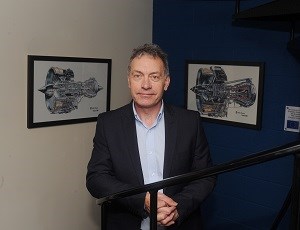Innovation nurtured by NATEP is beginning to enter the commercial arena, underscoring the programme’s real contribution to UK industrial growth. Chuck Grieve reports.
Three years ago, Warwickshire-based ANT Industries was part of a consortium of SMEs that received funding under the UK’s national aerospace technology exploitation programme (NATEP) to work with the Manufacturing Technology Centre (MTC) in Coventry on process optimisation for aerospace alloys.
At the time, the company was grappling with problems associated with producing large-diameter, thin-section rings for engines. Managing director Shaun Rowley said the company was looking for a more generic understanding of how materials behave during machining.

The work paid dividends at the end of 2016 when ANT landed business worth £25 million over five years from ITP, the Spanish aero engines and components manufacturer, to produce parts for a number of engine programmes, including the Rolls-Royce Trent 1000 and Pratt & Whitney PW815.
ANT isn’t alone in seeing its NATEP project work bear fruit. South West SMEs Cabot Design and Gingerneering netted two contracts for the application of their aluminium alloy failure modelling. Devon-based Helitune is heading for supplemental type certification (STC) of its new vehicle health monitoring system (HT-VHM). And Midlands-based ConsultAvila expects a commercial version of the inventory management software developed with the aid of a NATEP grant to be available later this year.
As NATEP enters a new phase, these and other projects from early calls are taking new technologies into the marketplace, creating jobs and strengthening the UK aerospace industry.
“The evidence to date shows that NATEP is what the supply chain needs,” said programme director Jeff Taylor. “It delivers what it says on the tin.”
Rowley said the NATEP work guided ANT to a simplified manufacturing route using calculated compensation error (CCE) – “effectively machining incorrectly, knowing the part will be correct when it’s completed,” he said. CCE is not new, but by approaching it scientifically, ANT could reduce the normal one-to-two-year product development process to a few months.
A fantastic opportunity
Peter Knight, technology manager at the Midlands Aerospace Alliance (MAA), said the NATEP project had also given ANT “a fantastic opportunity” to validate an investment strategy. In this case, it saved ANT from the costly purchase of a special five-axis numerical control (NC) machine, which the company thought was the only way to achieve the necessary accuracy. The work with MTC showed that, by re-thinking the fixturing, tooling and manufacturing sequence, ANT could make the parts on its ‘conventional’ five-axis machines.
“Most companies, particularly SMEs, don’t get that opportunity: they just have to follow their instinct and hope for the best,” said Knight.
Rowley said the NATEP project provided a gateway to the technology and experts at the MTC. “It’s always a challenge for an SME to find the time for research and development. When you can sit with experts, you get new ideas that challenge what you do. For us, that was a bonus.”
NATEP funding also enabled Cambridge-based Heraeus Noblelight (HN) to prove its innovative Humm3 technology and run technology demonstrations for automated fibre placement (AFP) and similar applications.
HN says the technology promises to transform composites manufacturing by delivering faster, uniform heat to the nip point area over a range of temperatures.
Testing, testing
Currently, three of the world’s leading manufacturers in this field are doing trials and integration work to incorporate Humm3 technology into their product portfolios, and several major airframe manufacturers are starting feasibility trials on the using it.
In their NATEP project, Cabot Design and Gingerneering tackled uncertainties over the behaviour of high-strength aluminium alloys by developing an innovative material model, validated by extensive testing, and integrated into commercial finite element software.
“For some of these high-strength alloys, relative performance in the short transverse grain direction is worse than conventional thinking would expect,” said Rich Davies of Gingerneering.
Rachel Stephenson, of Cabot Design, added: “The material model will give a better understanding of the complex failure mechanism of high-strength alloys and other orthotropic materials with cross-sector benefits to any industry in which advanced materials are used.”
Exposure through the NATEP programme has led to possible further work for Cabot Design: the company is in discussions with a large tier-1 aerospace company for new innovation projects or follow-on work.
Another southwest success story is the HT-VHM developed by Helitune of Torrington, Devon. This innovative system, which continuously collects and stores vibration inputs, speed references, blade tracking data, GPS and inertial data, has completed flight trials on an AgustaWestland AW109 light helicopter from the Castle Air fleet. The company is aiming for STC with the support of Leonardo-Finmeccanica.
The system has been designed and developed for compatibility with a wide range of platform sizes and requirements. “HT-VHM is the next generation of on-board systems,” said Helitune technology manager, Peter Morrish. “It is small enough and cost-effective for lighter platforms in its basic configuration, and yet offers excellent value for money in its enhanced configurations for the larger platforms.”
Helitune is now working directly with a number of helicopter original equipment manufacturers in preparation for implementation of the newly developed system.
Integration matters
ConsultAvila director, Dr Dudley Wood, said his company had “talked to a lot of people, shown them early demonstrators and found exceptional interest” in the visual inventory optimisation system (VIOS) software developed jointly with partner CANDA Systems.
VIOS is being “fully integrated” with Valuechain Technology’s manufacturing supply chain software. It will also be marketed as a standalone product, he added.
Dr Wood said inventory “is a big issue for many businesses in the aerospace sector, particularly if they have complexity, variety and volume, and aged stock.”
VIOS displays part stock levels, replenishment and consumption on a management ‘dashboard’ using data visualisation to facilitate dynamic inventory planning and control.
Yeovil-based Invirt Reality expects an airline customer to begin training cabin crew within six months using the virtual reality (VR)-based training system developed in its NATEP project.
Technical lead, Mark Lewis, said NATEP helped Invirt, a specialist VR and interactive 3D visualisation company, develop the “next generation of training for the next generation of trainees”.
The competitive price, ease of use, and believability, of the VR environment made a strong business case for developing a training system in a regulated industry, where Invirt has expertise. Its project partners were the University of Exeter and Flybe.
During evaluation by the university, academics discovered that VR training was less stressful than traditional methods, and as effective.
The project team is talking with airlines and has strong prospects in the rail industry. Lewis said the oil and gas and nuclear energy industries were also potential markets.
Bristol-based BOXARR expects its innovative supply chain risk analysis and alerting system, developed with NATEP project partner i3Works, to be on sale by the end of the year.
Even at the project’s halfway point, the signs point to a strong uptake.
Chief executive, Alasdair Pettigrew, said BOXARR had made a mark in interdependent systems management (ISM) software, which addresses a relatively new and complex problem in manufacturing.
Managing disruption
The NATEP project aims to manage potential disruptions in the supply chain with an automated system to capture live event data, filter it for relevance to the end-user, and send alerts via BOXARR ISM software.
Airbus, the end-user in this NATEP project, has just awarded BOXARR a four-year extension to a current contract, which Pettigrew says demonstrates the prime’s confidence in its supplier. While this has nothing materially to do with NATEP, he said he was “sure [NATEP] contributed”.
Through the NATEP project definition and bidding process, BOXARR has brought “benefit to Airbus without being asked”, which goes down well with an OEM.
“That benefit of NATEP is probably undervalued by participants and government.”

